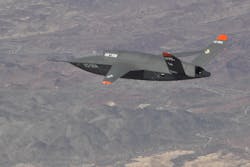Low-Cost UAV Reaches New Heights During Testing
Showing that low-cost procurement and design can lead to successful development, the U.S. Air Force Research Laboratory (AFRL) and partner Kratos Defense & Security Solutions, Inc. successfully completed the fourth test flight of the XQ-58A Valkyrie UAV demonstrator at Yuma Proving Ground in Arizona. By flying the test vehicle to higher altitudes than previously, it was possible to collect test data in an operating environment closely reflecting real-world flight conditions.
According to AFRL XQ-58A Program Manager Michael Wipperman, the flight met all of its expanded test objectives before its safe landing: “Flying at this altitude helped us gather important data such as vehicle response to temperature and vibration, which will prepare us as we move toward our next flight test.” This testing follows a successful 90-min. flight in Oct. 2019 that was marred by a faulty landing. Information gathered during a Safety Investigation Board probe into that landing provided guidance for the successful landing during the fourth test flight.
“We’re very pleased with the outcome of this fourth flight test, we were able to show recovery for a successful flight at even higher altitudes,” said Wipperman. “Given that we have overcome these challenges, we have confidence that the aircraft can continue its progression into flying in more representative conditions.”
The XQ-58A UAV is part of AFRL’s Low Cost Attritable Strike (LCAS) program, to be a runway-independent, reusable UAV capable of multiple remote operational missions. It has been developed through low-cost procurement and is designed to be less expensive than traditional piloted or unpiloted vehicles. The program has required less than 2.5 years from the contract award to first flight, with five test flights planned for the unmanned strike vehicle.
About the Author
Jack Browne
Technical Contributor
Jack Browne, Technical Contributor, has worked in technical publishing for over 30 years. He managed the content and production of three technical journals while at the American Institute of Physics, including Medical Physics and the Journal of Vacuum Science & Technology. He has been a Publisher and Editor for Penton Media, started the firm’s Wireless Symposium & Exhibition trade show in 1993, and currently serves as Technical Contributor for that company's Microwaves & RF magazine. Browne, who holds a BS in Mathematics from City College of New York and BA degrees in English and Philosophy from Fordham University, is a member of the IEEE.
